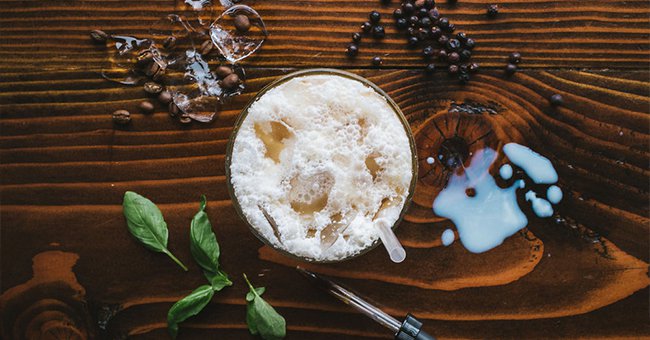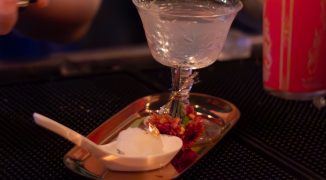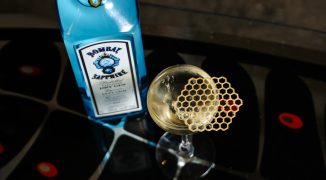As brisk fall weather rolls in, tenders of the bar reach for subtle, warming elements to keep drinks comforting. And what elixir has the perfect balance to start a day or end a night? Coffee.
From the age old film tropes of a grizzled detective spilling some unidentifiable booze into their morning cup of joe to Irish coffees developed in a San Franciscan bar in the 1940s, coffee and cocktails have a long standing history as drinking companions. After all, mixology is all about finding that sweet spot of balance in a cocktail—one in which the flavors complement each other, build and meld together into a cohesive sip, and coffee offers complexity and craveability ideal for a cocktail input.
These days it’s not just bars experimenting with espresso shots, cold-brewed coffee and nitro on their menus. Coffee shops and bespoke roasters are getting in on the action, offering creative takes on everything from Irish coffee to Black Russians. So we sat down with innovative bars and coffee houses developing programs on both fronts that leverage the caffeine-laden potion in signature sips at their establishments.
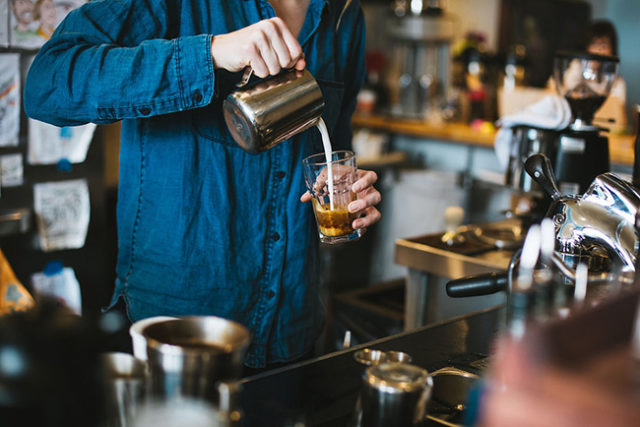 Coffee cocktails are made with the flavor profile of the particular beans and roasts in mind at Five Watt Coffee in Minneapolis, MN. Photo by Bethany Platter.
Coffee cocktails are made with the flavor profile of the particular beans and roasts in mind at Five Watt Coffee in Minneapolis, MN. Photo by Bethany Platter.
Not-So Strange Bedfellows
In a lot of ways, baristas and bartenders are cut from the same cloth. Both understand what flavors complement and play well with each other, display artful technique in preparing said beverages and, most importantly, possess the mental resolve to serve a deluge of crazed patrons that need their fix in the morning and evening.
Julie Lozano of New Orleans-inspired coffee shop and bar, The Honeymoon Cafe & Bar in Houston, TX has played both of these roles and notes the parallels. “I feel like using coffee isn’t a newfangled concept in cocktails. I worked in coffee for six years before I ever got behind the stick,” says Lozano. “When you talk to guests about different roasts you immediately notice that you tend to use a lot of the same language to describe different spirits, so it’s really just an extension of the bar.”
And while it’s good to have both fields of experience, sometimes having specialized knowledge in only one of the two opens the door to collaboration. “Having a specialty coffee shop that serves cocktails, what’s better than having a coffee or tea cocktail? The word barista means ‘bartender,’ so it all makes sense,” explains Daniela Staiculescu of Atlanta, Georgia coffee shop, Condesa Coffee. “The idea sometimes starts with a barista working on their signature drink, and then this idea needs a mixologist, or the barista himself, to come up with the most balanced and delicious beverage.” Lozano further details, “You have these bartenders who can pinpoint different flavors in amaros or fortified wines but don’t have a palate for coffee because it’s unfamiliar territory, so you ask for help from your baristas and talk to them about the characteristics of different roasts and how to potentially pair that with cocktails or spirits – or even ask them to make a roast with the characteristics you’re looking for.”
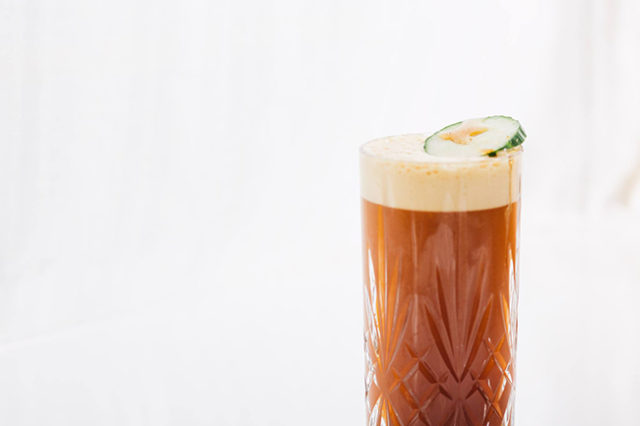 The Daily Press’ coffee cocktails are non-alcoholic, but they leverage syrups, shrubs and bitters to add a level of complexity. Photo by Joshua Vasko
The Daily Press’ coffee cocktails are non-alcoholic, but they leverage syrups, shrubs and bitters to add a level of complexity. Photo by Joshua Vasko
Caffeine Come-up
Deeply understanding coffee as a flavor component is a difficult undertaking due to incalculable variations in bean roasts and regions from which the beans hail. Add this intricacy to the seasonally-inspired trends in the cocktail industry, and you’ve got a recipe for something special. “Coffee is such a unique ingredient — different roasts vary in respect to acidity, brightness, floridity, earthiness, I mean, there are a million different variations of different roasts and it’s up to the bartender to choose what in that roast they want to showcase and how to use it in an interesting way,” says Lozano.
Take the recent uptick in affinity for cold press and nitro coffee that has caffeine aficionados clamoring to experience the best. “There’s endless ways to derive flavor in liquid format, and most of those ways haven’t been explored in a coffee drink yet. I’m always interested in finding new ways to pull flavor that work in the context of coffee,” says Lee Carter of Five Watt Coffee in Minneapolis, MN. Carter goes on, “Cold press is a fantastic use of coffee in cocktail and can be used in various levels of strength as a perfect cocktail mixer.” Nitro coffee is also a hot number as seen at Atlanta, GA craft cocktail house, Ration & Dram. Bar manager Kysha Cyrus is proud that they were the first in the city to make nitro coffee in-house and to use it in their cocktail creations. “[Nitro] gives the drink the creamy texture people might look for without the addition of milk or cream. No shaking. The cocktails are about showcasing the nitro coffee and not losing the spirit,” says Cyrus.
There’s even a cadre of establishments that have nixed booze in favor of virgin plays on coffee-tails that leverage syrups, shrubs and bitters to add a level of complexity. “The coffee cocktails I make at the shop are non-alcoholic and built around the naturally occurring flavor notes in each coffee,” says Lindsey Pitman of The Daily Press in Charlotte, NC. Although they intend to add some alcoholic versions in the future, Pitman notes that, “The alcohol is a flavoring ingredient – not a main focus.”
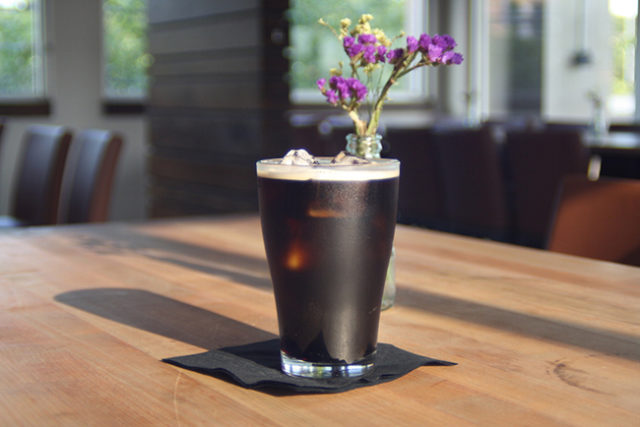 Ration & Dram’s Rise ’N’ Shine coffee cocktail uses house-made nitro coffee. Photo credit: Caitlin Crawford
Ration & Dram’s Rise ’N’ Shine coffee cocktail uses house-made nitro coffee. Photo credit: Caitlin Crawford
Definitely Try This at Home
Although coffee cocktails have been around for the past 100 hundred years, it wasn’t until the inception of the Irish coffee in the 1940s that raised the status quo for this combo. Hot coffee, Irish whiskey and sugar topped with whipped cream is the way we all should start our mornings, and barkeeps around the globe have been upping the ante ever since through innovative and creative takes on this classic.
Condesa Coffee goes the salacious route with a play on the White Russian called the “Dirty Russian.” An espresso shot plays first chair in this symphony of pecan vodka, black walnut bitters, cream and vanilla. “This drink makes you enjoy a low percentage of alcohol, with a very smooth coffee taste in a medium body cocktail,” says Staiculescu.
Ration & Dram’s “Rise ’N’ Shine” favors the rich, creamy nitro coffee they make in house paired with Troy and Sons moonshine, Averna amaro and vanilla syrup. The first incarnation featured coffee cream soda and the addition of Amarula and Blackwell Jamaican rum. What we wouldn’t give to start our morning with that.
The Honeymoon Cafe & Bar’s “Coal Miner’s Daughter” channel flavors you wouldn’t expect to work together, which made it an instant hit with patrons. Utilizing a special roast with bright, fruit-forward acidity and notes of fresh blueberry, they included bourbon, lemon juice, honey and rosemary. “When you branch out from the things you generally pair with coffee like, vanilla or milk, and use things like orange juice or tonic water, you take the complexity of coffee and cocktails to another level and that’s where the fun really begins,” Lozano explains.
The landscape is changing, and while this new trend of craft coffee-tails is definitely uncharted territory, the boozy, caffeinated combination of coffee and alcohol should be embraced as a worthy asset in every bartender’s repertoire.


